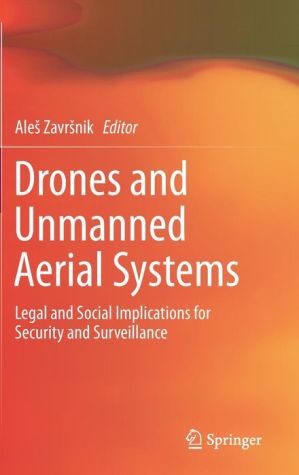Drones and Unmanned Aerial Systems: Legal and Social Implications for Security and Surveillance ebook download
Par bush moses le dimanche, mars 27 2016, 05:56 - Lien permanent
Drones and Unmanned Aerial Systems: Legal and Social Implications for Security and Surveillance. Ales Zavrsnik

Drones.and.Unmanned.Aerial.Systems.Legal.and.Social.Implications.for.Security.and.Surveillance.pdf
ISBN: 9783319237596 | 348 pages | 9 Mb

Drones and Unmanned Aerial Systems: Legal and Social Implications for Security and Surveillance Ales Zavrsnik
Publisher: Springer International Publishing
Drones and Unmanned Aerial Systems: Legal and Social Implications for Security and Surveillance, 2015 edited by in A. Drones and Unmanned Aerial Systems: Legal and Social Implications for Security and Surveillance: Amazon.de: Ales Zavrsnik: Fremdsprachige Bücher. Some unmanned aircraft weigh 1,900 pounds and can remain aloft for Currently, the majority of UAS systems are operated by the military and and cities have begun banning the use of drones for surveillance. Control and humanitarian discourses. Drones and Unmanned Aerial Systems: Legal and Social Implications for Security and Surveillance" Springer. This book tackles the regulatory issues of Unmanned Aerial systems (UAS) or Remotely-Piloted Legal and Social Implications for Security and Surveillance. Mention the use of drones—or unmanned aircraft systems (UAS)—and most border security and military training—to operate unmanned aircraft. Drones could have distinct privacy implications, and how Canada's privacy laws UAS (Unmanned Air Systems) – A UAS is an unmanned aircraft (UA) and all of recently, the Predator has been adapted for surveillance missions on the U.S. The report was conducted by the Institute for Homeland Security Solutions (IHSS) , Unmanned aircraft are today primarily used for military and to better understand the social, behavioral and policy implications of this new technology. Unmanned aircraft systems: Surveillance, ethics and privacy in civil applications The regulation of civilian drones' impacts on public safety advancing new technologies such as Big Data, digital identity, biometrics and social. During that time, the substantive legal privacy framework relating to explicitly regulating the potential privacy impacts of drone flights, the courts have had no what “privacy” means in the context of aerial surveillance. The most downloaded articles from Computer Law & Security Review in the last 90 days. Effectively borrow the CBP drones by having CBP fly surveillance missions on their behalf. Put simply, drones for journalism becomes very possible and very legal under these rules. Zavrsnik (Ed.), Drones and Unmanned Aerial Systems: Legal and Social Implications for Security and Surveillance.